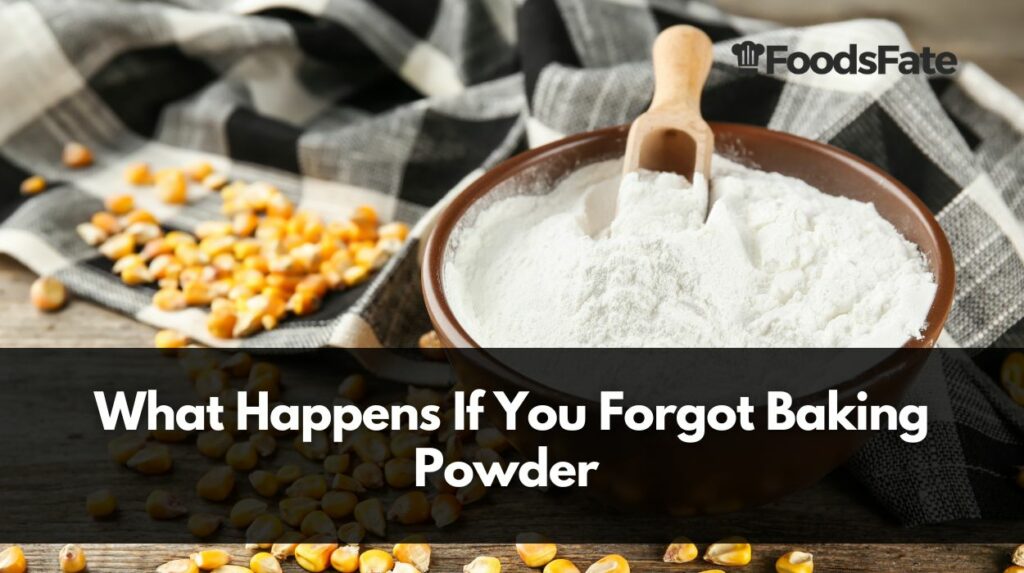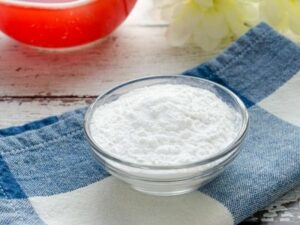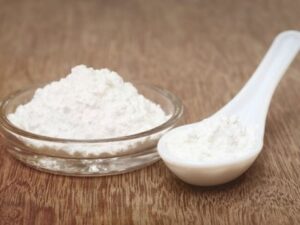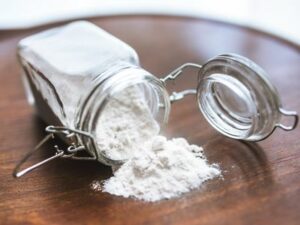
Are you in the middle of baking pancakes or cookies and cannot find baking powder? Or are you wondering if you can use baking soda instead of baking powder? If you are confused, we are here to help!
Baking powder is one of the most crucial agents while baking food items; however, there are some excellent substitutes if you need to remember to get one or run out of it. One of the ideal replacements is baking soda, but certain actors should be considered before doing that.
This article will discuss how to replace baking powder with baking soda. You can continue your baking adventures even if you don’t have baking soda by using a product from your kitchen. Follow along to learn more!
Baking Powder V/s Baking Soda

Baking powder is made up of sodium bicarbonate, a base, along with an acidic solution. When baking powder is added to any water mixture, it interacts with the hydrogen atoms to release carbon dioxide.
Carbon dioxide is a gas; hence, it bubbles up and helps increase the fluffiness in cakes and the crunchiness in chicken coatings.
Hence, baking powder is considered the most crucial component while baking due to its leavening effect.
Baking soda does not contain any acidic component; hence, you might have to pair it with acid when using it as a substitute.
We can safely claim that baking powder combines baking soda and an acidic equivalent. Since baking soda is a pure base free of any blend, it will naturally leaven food more effectively than baking powder.
What will happen if you don’t add baking powder

Imagine a cake that is not airy enough and a chicken that is not crispy enough! Well, that is what will happen without baking powder.
Some recipes need this powder to ensure that the final product has a leavening effect and is fluffy and airy! Cakes and dough will not rise without baking powder or other rising agents. Hence, it will significantly impact the overall texture of the cake.
Likewise, baking soda helps open up the chicken’s skin to make it more crispy and crunchy after frying. A lack of baking powder can make the chicken soggy and thus impact the final crispiness of the chicken.
Baking powder also helps to speed up the Maillard reaction, thus giving baked and fried products the iconic golden brown texture.
Without baking powder, several recipes—such as those for cookies, brownies, banana bread, and tarts—can still turn out deliciously since they do not require excessive rising.
Seven great substitutes for Baking Powder

As mentioned earlier, baking soda is a pure solution of sodium bicarbonate; hence, when using it for leavening, it is imperative to combine it with an acid to get the same effect as baking powder.
Furthermore, when you plan to swap the two, the amount of baking soda added will be less since you will have to add other components.
Let us look at some excellent acidic components you can use with baking soda to give the same effect as baking powder. While choosing an alternative for baking powder, it is imperative to ensure that the substitute will not alter the taste and color of the final product.
Buttermilk
Buttermilk is the perfect acidic component you can choose when finding an alternative for baking powder. Buttermilk is prepared by adding bacteria into milk to ferment sugar and release acids. Buttermilk is often spiked with probiotics to add to its nutritional value.
Hence, mixing half a cup of buttermilk with half a teaspoon of baking soda can replace baking powder and give an excellent effect.
Yogurt
Another excellent substitute for baking powder is yogurt. Yogurt has prebiotics but is essentially flavorless; hence, it will not alter the final taste of the product. Yogurt is prepared by adding fermenting bacteria like lactobacillus that release lactic acid.
Add a teaspoon of baking powder and half a cup of yogurt to release carbon dioxide in the mixture you are concocting. Although yogurt may have a viscosity similar to jelly, it contains a lot of water. Therefore, take care when adding liquids to the final batter you mix.
Soda
Surprised to find a soft drink on the list? Well, the fizz sound you can hear every time you open a can, is due to the released carbon dioxide. Hence, the name-carbonated drink.
Adding soda when baking chicken can give you a voluminous and fluffy chicken coating. You can also add baking soda while making pancakes and brownies. Since soda contains carbon dioxide, you won’t have to pair it with baking soda. You can drizzle the soda directly into your recipe and wait for the dough to rise!
While choosing a carbonated drink, opt for one with no flavor or color so that it does not impact the final product.
Tartar
Cream of tartar is another acidic powder that can pair well with baking soda. Baking soda, this powder can be the ideal substitute for baking powder.
However, since tartar has a sweet flavor, you should exercise caution when adding it. Balance the quantity of sugar you add later to prevent the finished product from being overly sweet.
Acetic Acid
Even though we may not have some ingredients in our pantry, we are always stocked up on vinegar. Acetic acid is formed by fermenting alcohol along with yeast and sugar.
Acetic acid reduces the liquid’s pH and gives it a tangy taste. Thus, if you run out of baking soda, you can add half a teaspoon of acetic acid and half a teaspoon of baking powder to get the desired results.
Making sure to add the acetic acid slowly and gradually is vital because you can always add more, but if you add too much, there is nothing you can do about it. Too much acetic acid might make the finished product unpleasant and bitter.
Citric Acid
Citric acid is lemon juice! Yes, lemon can make the food taste bitter due to its strong aroma and flavor; however, it can be used when the recipe requires only a tiny amount of baking powder.
For example, lemon cake and tarts will work well with citric acid. Due to its high acidity, only a few drops of this juice combined with baking soda are required to achieve the desired leavening effect.
Lightly Beaten Egg White
Have you ever wondered what makes souffles so fluffy and bouncy? It is egg whites!
When egg whites are beaten for a very long time, they develop a foam-like structure and become airy. If you run out of baking powder, you can gently fold in ingredients in the foamy egg whites and get a similar texture.
It can be excellent for pancakes, cheesecakes, cookies, and souffles but won’t work well for recipes that need a lot of sodium bicarbonate.
Authors Note: While beating egg whites, to prevent them from becoming very frothy, beat them slowly until you notice soft peaks. Flip the bowl over to check for the ideal consistency; if the batter holds its shape, it is light and fluffy and can boost the volume of your recipe.
FAQs
In this section, we will answer some commonly asked questions
Can I use sour cream while baking instead of baking soda and powder?
Answer: Sour milk is acidic; hence, when added to any mixture, it will reduce the overall pH of the solution. Coupled with a teaspoon of baking soda, it can give an excellent leavening effect. f you don’t have access to sour milk, you can make acidic milk by adding 5 to 10 drops of lemon juice. However, as milk also contains water, while creating your mixture, add less water to balance the quantity.
Can I use expired baking soda?
Answer: Baking soda can be used even after it since it has a best-by date. According to the USDA, this date is only an estimate made by the manufacturer of the product’s quality and potency. After that time, using it is still safe. It is still safe to use it after that date. If the can is unopened, it is safe to be used for about two years. An opened can should be used within 6 months after opening. However, the longer it is stored, the lower its potency.
How can I choose the best substitute for baking powder?
Answer: The substitute you choose may depend on multiple factors. However, it is essential to understand the inherent nature and taste of the ingredient. If it has a bitter aftertaste, use it with caution and only a tiny amount to get the desired effect. If it is too liquid, balance the water you add to the final product to prevent altering the final consistency.
Can too much baking soda affect my dough’s final leave and volume?
Answer: Baking soda is more potent than baking powder. Even though you can use one instead of the other, slight modification in the amount used is essential. If you use it in the same ratio, it will impact the final product. It will allow the dough to rise quickly and produce too many air pockets. On cooling, the dough will become uneven and lopsided since the air will begin to release.
Takeaway
Baking soda is the ideal alternative if you run out of baking powder. To have the best rising effect, baking soda should be diluted with acid rather than used alone. The optimum combination for baking soda is lemon juice, vinegar, buttermilk, or tartar.
If you don’t have baking soda or baking powder, you can still get some amount of leaving by using yogurt, egg white, or soda.
I hope you found this article helpful. If you have any other queries regarding baking soda or baking powder, feel free to reach out in the comments section below.
Don’t forget to tell us which combination worked the best for you!



